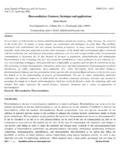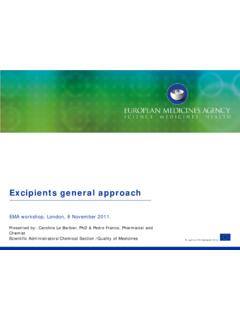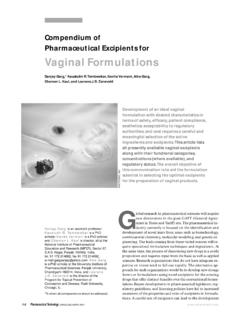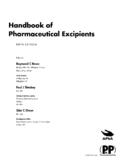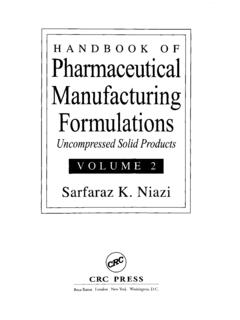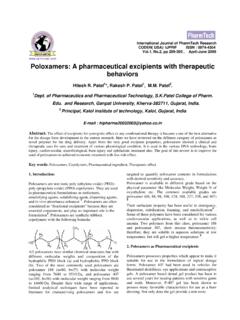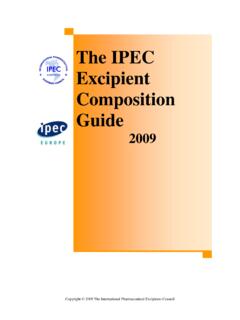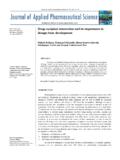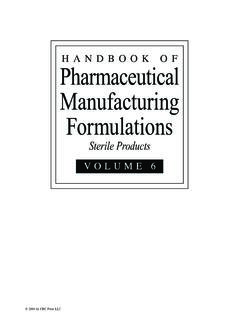Transcription of Natural Excipients: A Review - AJPLS
1 Asian Journal of Pharmacy and Life Science ISSN 2231 4423 Vol. 2 (1), Jan-March,2012 97 | P a g e Available online on Review Article Natural excipients : A Review Tekeshwar Kumar*, Shailendra Kumar Gupta, Mukesh Kumar Prajapati, D. K. Tripathi, Vikas sharma and Paridhi jain Rungta College of pharmaceutical Sciences & Research, Kohka Road, Kurud, Bhilai-491024, India *Correspondence author Email: Contact: +91-9827985722 ---------------------------------------- ---------------------------------------- ---------------------------------------- ------------------ Abstract The use of Natural excipients to deliver the bioactive agents has been hampered by the synthetic materials.
2 However advantages offered by these Natural excipients are their being non-toxic, less expensive and freely available. The performance of the excipients partly determines the quality of the medicines. The traditional concept of the excipients as any component other than the active substance has undergone a substantial evolution from an inert and cheap vehicle to an essential constituent of the formulation. Earlier used Natural excipients are carrageenan, thaumatin, lard, shilajit, aerosil, myrobalan, storax.
3 excipients are any component other than the active substances intentionally added to formulation of a dosage form. Novel drug delivery systems are developed to address the challenges of drug development such as bioavailability, permeability, and poor solubility. Global excipient markets are expected to grow rapidly with the emerging trends in the pharmaceutical industry. The pharmaceutical industry is marketing refinement in the physical structure of active pharmaceutical ingredients (APIs). This article gives an overview of Natural excipients which are used in conventional dosage forms as well as novel drug delivery systems.
4 Keywords: Natural excipients , aerosol, storax, guar gum, alginates ---------------------------------------- ---------------------------------------- ---------------------------------------- ------------------ Introduction excipients were defined as the substance used as a medium for giving a medicament , that is to say with simply the functions of an inert support of the active principle or principles. [1] The specific application of Natural poly-saccharide polymers in pharmaceutical formulations include to aid in the processing of the drug delivery system during its manufacture, protect, support or enhance stability, bioavailability or patient acceptability, assist in product identification, or enhance any other attribute of the overall safety, effectiveness or delivery of the drug during storage or use.
5 [2] Today we have several pharmaceutical excipients of plant origin, like starch, agar, alginates, carrageenan, guar gum, xanthan gum, gelatin, pectin, acacia, tragacanth, and cellulose. These Natural excipients find applications in the pharmaceutical industry as binding agents, disintegrates, sustaining agents, protective s, colloids, thickening agents, gelling agents, bases in suppositories, stabilizers, and coating materials. The advantages of Natural plant-based excipients include that they are of low cost, Natural origin, fairly free from side effects, biocompatible, and bio-acceptable, with a renewable source, environmental friendly processing, local availability, better patient tolerance, as well as public acceptance.
6 [3] excipients are also derived from Natural sources, synthesized chemically, or prepared semi-synthetically starting from Natural sourced materials. They range from simple, usually well-characterized, organic or inorganic molecules to highly complex materials that are difficult to fully characterize. Classification of excipients is based on their role in the pharmaceutical formulation, Asian Journal of Pharmacy and Life Science ISSN 2231 4423 Vol. 2 (1), Jan-March,2012 98 | P a g e Available online on Review Article their interactions influencing drug delivery, or their chemical and physico-chemical properties.
7 [4] excipients are also sometimes used to bulk up formulations that contain very potent active ingredients, to allow for convenient and accurate dosage. Depending on the route of administration, and form of medication, different excipients may be used. To stabilize the active ingredient, excipients are added, ensuring that the active ingredient stays "active", and, just as importantly, stable for a sufficiently long period of time that the shelf-life of the product makes it competitive with other products. excipients also can serve to mask an unpleasant taste or texture and help ensure that the right amount of the API makes it to the right spot in the body at the right time.
8 [5] (Table 1) a Polysaccharides in pharmaceuticals Natural polysaccharides are extensively used for the development of solid dosage forms. These polymers of monosaccharide s (sugars) are inexpensive and available in a variety of structures with a variety of properties. They are highly stable, safe, non-toxic, and hydrophilic and gel forming in nature. Pectin s, starch and amylase are a few polysaccharides commonly used in controlled release dosage forms. Non-starch, linear polysaccharides remain intact in the physiological environment of the stomach and the small intestine, but are degraded by the bacterial inhabit-ants of the human colon which make them potentially useful in targeted delivery systems to the colon.
9 [6] Gums and mucilage Gums are considered to be pathological products formed following injury to the plant or owing to unfavorable conditions, such as drought, by a breakdown of cell walls (extra cellular formation; gummosis). Mucilage s are generally normal products of metabolism, formed within the cell (intracellular formation) and/or are produced without injury to the plant. Gums readily dissolve in water, whereas, mucilage form slimy masses. Mucilage s are physiological products. [7] (Table2) b, (Table3) c and (Table4) d Pectin: Pectins are non-starch, linear polysaccharides extracted from the plant cell walls.
10 [34] In the food industry, folic acid incorporated microcapsules were prepared using alginate and combinations of alginate and pectin polymers so as to improve stability of folic acid. The blended alginate and pectin polymer matrix increased the folic acid encapsulation efficiency and reduced leakage from the capsules as compared to those made with alginate alone, they showed higher folic acid retention after freeze drying and storage. [35] (Table5) e and (Table 6) f Alginates Alginates are Natural polysaccharide polymers isolated from the brown sea weed (Phaeophyceae).
